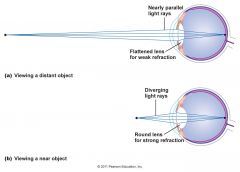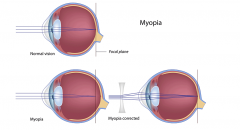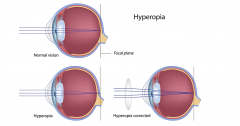![]()
![]()
![]()
Use LEFT and RIGHT arrow keys to navigate between flashcards;
Use UP and DOWN arrow keys to flip the card;
H to show hint;
A reads text to speech;
34 Cards in this Set
- Front
- Back
|
What is the sclera? Where does it specialise? |
1. The sclera is a white capsule around the eye.
2. At the anterior surface of the eye the sclera specialises into the cornea. |
|
|
What is the function of the sclera? |
A tough area which serves as an insertion point for external muscles that move the eyeball. |
|
|
What is the choroid layer? |
Darkly pigmented layer which is found at the back and at the front of the eyeball. |
|
|
What is the function of the choroid layer? |
At the back of the eyeball it absorbs light rays. At the front of the eyeball it is specialised into the iris, ciliary muscle and zonular fibres. |
|
|
How is the diameter of the pupil determined? |
Smooth muscle of the iris determine the diameter of the pupil. |
|
|
What is the function of the ciliary and zonular fibres? |
Ciliary muscles causes tension on the zonular fibres when contracted. The tension in the zonular fibers changes the shape of the lens - thus determining its focusing power. |
|
|
What does the retina form? |
Forms the inner posterior surface of the eye |
|
|
What is the sensory receptor of the eye called? |
The photoreceptor. |
|
|
What is the macula lutea? |
The macula lutea is an oval-shaped pigmented area near the center of the retina of the human eye. |
|
|
What is the Fovea Centralis? |
Central shallow pit containing a very high number of cone cells. |
|
|
What is the function of the fovea centralis? |
Specialised in delivering high visual acuity. |
|
|
What is the optic disc? |
Where neurons exit the eye to the brain in the form of the optic nerve. |
|
|
What are the two major subdivisions of the eye? What is the main composition of each? |
1. Anterior chamber - filled with aqueous humor 2. Posterior chamber - filled with vitreous humor |
|
|
What is refraction? |
The phenomenon that when light moves from air to a denser medium it will bend. |
|
|
How does 'refraction' help us to see? |
Refraction allows us to focus an accurate image of an object onto the retina. |
|
|
When an object is: 1. Close 2. Far away how must refraction be manipulated to focus the image on the retina? |

1. When an object is close to the eye it must be refracted at greater angles to converge on the retina. 2. When an object is far away from the eye it must be refracted at very low angles to converge on the retina. |
|
|
What dictates the level of refraction of light entering the eye? |
The shape of the lens. |
|
|
How is the shape of the lens controlled? |

The shape of the lens is controlled by the ciliary muscles which contract/relax the zonular fibres. Ciliary contraction = zonular relaxation Ciliary relaxation = zonular contraction |
|
|
What happens to the lens during the ageing process? |
As people age the lens tends to lose elasticity, reducing its ability to assume a spherical shape. |
|
|
What does the lessening elasticity of the lens with age cause? |
Progressive decline in the ability to accomodate for near vision |
|
|
What is the scientific term for losing the ability to focus on close objects? |
Presbyopia |
|
|
Why over time does the lens lose its elastic properties? |
The central cells in the lens cannot divide and over time yellow and then black. Acquiring a dense, stiff complexion |
|
|
What are cataracts? What is a major causative agent? How are cataracts treated? |
1. Clouding of the lens over time 2. UV light partially to blame 3. Can be surgically removed but ability to accommodate is lost |
|
|
What is: 1. The scientific term for nearsightedness? 2. Why does nearsightedness occur? 3. How is it corrected? |

1. Myopia 2. Eyeball too long in relation to the lens - images focus in front of the retina 3. Convex lens |
|
|
What is: 1. The scientific term for farsightedness? 2. Why does farsightedness occur? 3. How is it corrected? |

1. Hyperopia 2. Eyeball too short in relation to the lens - images focus behind the retina. 3. Concave lens |
|
|
What is astigmatism? |
When the lens or cornea is not smoothly spherical. |
|
|
What condition relates to the maintenance of the aqueous humor in the eye? |
Aqueous humor is constantly formed and drained at the edge of the cornea. If formation is greater than drainage this can lead to increasing intraocular pressure = glaucoma. |
|
|
What is the result of glaucoma? |
Permanent damage of retinal cells through increased intraocular pressure. |
|
|
What does the iris regulate? |
The diameter of the pupil. |
|
|
What does the diameter of the pupil dictate? |
As the iris blocks the passage of light and the pupil does not. The diameter increases the amount of light which enters the eye. |
|
|
How is the iris composed? |
The iris is composed of two layer of smooth muscle that are innervated by autonomic nerves. |
|
|
How does the nervous system influence the diameter of the pupil? |
1. Sympathetic stimulation of the iris = enlarged pupil. 2. Parasympathetic stimulation of the iris = smaller pupil. |
|
|
How and why does the pupil diameter change in bright light? |
When bright light is detected the pupil diameter is decreased. This prevents the light from flooding the vision allowing for very focused vision. The decrease in size of the pupil also protects the retina from damaging, very bright light. |
|
|
How and why does the pupil diameter change in low light level environments? |
Dilation of the pupil allows limited light to fill the eye allowing for vision in dim light conditions. |

